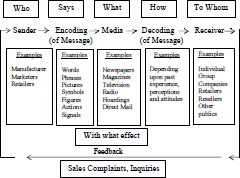The word ‘communication’ is based on the Latin word meaning ‘common’. Thus, the term communication has come to mean sharing something of common use. In marketing, communication has a very important place.
It is that function of marketing that is charged with the task of informing the target customer about the nature and type of the firm’s products and services, their unique benefits, uses, and features as well as the price and place at which those would be available in the marketplace. Marketing communication is more commonly called ‘promotion’ and constitutes one of the Ps of the marketing mix.
A study of marketing communication, therefore, is a study of the promotion function of marketing. Notwithstanding the continuing debate, on whether a promotion is the first element of the marketing mix or the last, the fact remains that sound management of the marketing function is dependent on effective management of its promotion function.
Read Also: Nature and Use of Price Discounts in Marketing
For example, in the success of the following products and services, the promotion function played a role of greater importance: Hot-shot camera, Maggie 2- minute noodles, KST fans, etc. to mention only a few. Similarly, examples of products that misfired due to faulty management of the promotion function are not far to seek.
With growing competition in the market, as well as the customers becoming better informed and more choosy, it is imperative now that marketing communications of the right kind only are made to the right group of target buyers. To understand how the promotion function can be managed effectively, let us begin by first taking a look at how communications work.
How Marketing Communication Works
We know by now that communication, simply speaking, is sharing of information between two parties. Such an exchange could be oral or written, personal or public, using words, figures, symbols, or a combination.
Read Also: Product Positioning and Price in Marketing
The process of communication begins when one party (called source, sender, or communicator) wishes to communicate with another party (the receiver). Communication is complete when the receiver understands in the same sense what the sender wishes to communicate. The various elements of a typical communication process are given in the figure below.

As stated above, communication is completed only when the receiver understands in the same sense what the sender wishes to convey.
The effectiveness of the communication process, therefore, is dependent upon the level of congruity and compatibility obtained among the various elements of the communication process, i.e., between the sender and the message, the message and media, the media and the receiver, and so on.
The incongruity and/or incompatibility between the various elements of the communication process might make the promotion function and in turn the marketing function, ineffective as is reported to have happened in the following two cases for example:
It is said that pork, launched more than a decade ago in Northern Nigeria, failed to take off primarily due to the manufacturer’s inability to get the concept of pork perceived distinctively from that of beef.
Not much different was the fate of an advertising campaign of a leading US detergent marketer who while extending the campaign to the vernacular press of the Middle East, erred in not reversing the direction of the visuals used, to make these compatible with the right to a left reading characteristic of the media.
Consequently, what the readers saw was that white and bright clothes when washed in the company’s brand of detergent came out dirty and soiled, thus, going contrary to what the advertiser desired.
Read Also: 7 Tips for Traveling with your Technologies for Easy Movement
